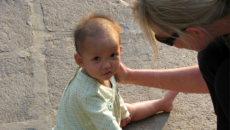Parenting a child often feels like a crash course in pop psychology. Decisions are based on opinion, the standards of our culture, how we were raised, or simple gut feeling. And parenting, like pop psychology, is not even remotely a science. While we’re all fairly certain we need to feed our little darlings for them to grow up healthy and strong, beyond that, we very quickly lose our sense of absolute clarity.
So we make choices, lots of them, every day, big and small. And some of the most contentious choices surround the issue of sleep.
For some children, bedtime is hard. Many are afraid of the dark. And when they wake up scared, or sick, or just lonely, they love to come into Mom and Dad’s bed for a cuddle. As for parents, well, we like our own sleep, our own intimacy. And there’s the issue of wanting to make our children “independent.”
If the kids crawl into our bed, how long do we let them stay? Five minutes, an hour? Or maybe we just let them start and end the night there, in “The Family Bed,” “co-sleeping.”
Children sleeping in their parents’ bed? It’s a subject guaranteed to start a spirited discussion, no matter who’s in the room. It’s sparked essays, studies, books, TV programs. There are Web pages galore; every parenting site offers opinions and how-tos. Government safety organizations have weighed in on it. And I’m sure your mothers have said a thing or two.
The concept is an old one, and many cultures have the family bed in one form or another — either the mother sleeps with the kids, or the entire family sleeps together. This is the way all people once slept, sharing the same room (or tent, or cave).
In the Western world, our notion of individualism includes children sleeping alone. But over the past 30 years, people have started to wonder if we’re missing something. Maybe we’re concentrating too much on independence, and not enough on nurturing and family.
So what’s good and bad about the family bed?
Proponents Say:
- It may reduce the risk of SIDS, because the child wakes up more often, sleeps less deeply. The parents are more aware of what is going on with the child’s breathing.
- It lets everyone sleep better, because the parents are not constantly getting up to check on their child or attend to their needs.
- It fosters closer bonding with the children. You’re there for them all the time; they don’t need to come and find you.
- It enhances parents’ intimacy, by making them more creative in finding intimate moments.
- It provides more close family moments. In our busy world, every moment with the kids is a precious one, so why not take an additional eight hours’ worth?
Those Against the Family Bed Say:
- It is dangerous. Parents can accidentally smother their children.
- It makes everyone’s sleep much worse. It’s hard enough sleeping with one person, let alone three or four.
- It impedes independence in children.
- It cramps parents’ intimacy.
As you can see, there is contradiction on every major point. So we come to the central questions: Is it for you and your family? And does co-sleeping (or choosing not to) mean anything special for adoptive families?
The Real Experts: Parents
I interviewed a number of parents — international adopters, domestic adopters, in blended families — and received a wide range of responses. Most adopted their children as infants, others when they were older.
First and foremost, they said that sleeping with children helps with bonding. While bonding is not an issue unique to adoption, it’s one many adoptive parents anticipate and plan for. Sharing a bed with a newly adopted child is one way to facilitate the process.
Beth Cavalli said, “Adopting an infant does not mean that there will be automatic attachment. It requires effort. [For adoptive families] the nine months’ time in utero and however many months in real-age bonding time have been lost. Infants need closeness. They need to feel safe. If the infant does not feel safe in a crib alone, bringing the infant into your bed will meet the need and enhance attachment.”
Michele St. Martin agreed: “For us, the family bed was a planned, short-term bonding tool. I don’t know that we would have considered it if our daughter had been born to us. We were concerned about bonding and attachment, and we decided prior to traveling to China to adopt Cassie that she would sleep with us, at least in the beginning.” Michele continues, “We had several reasons for this: first, we wanted to have the close, skin-to-skin contact that would be possible if we slept together. And second, we thought it would be reassuring to her to not be alone in a crib. She was used to being in a room with lots of other babies, and we were sensitive to the fact that she was going through huge changes.”
Michele went on to say that bonding has not been a problem, and that Cassie now sleeps mostly in her own bed.
Our children have been in orphanages, moved through foster homes, or, at the very least, changed primary caregivers. Fear of abandonment and loss can cause night fears; many parents believe that sleeping in the family bed can alleviate them.
Sally Herpst said, “When I received my first daughter, age of 10 months, she did not seem to want to sleep with me, but I placed her crib next to my bed so I could respond to her immediately. She had enormous sleep problems the first year home — night terrors almost every night. She slept her entire second year home next to me in my king-sized bed. I think this was extremely helpful in allaying her high anxiety levels, and as we waited for the referral of baby sister, she started to sleep in her own bed (in my room, next to mine).”
Sally continues, “Our setup now is the two girls share a room, with my room right across the hall. They can join me if needed, and the older one still does frequently. This occurs when she is feeling especially anxious or needy, and our physical proximity seems to result in better ability to cope during the day.”
Some parents I interviewed stated that they had planned to use the family bed from the start, but many more said it had just seemed unavoidable. As Elise Geither explained, “Letting her cry until she fell asleep was not an option; she threw up after just a few minutes of crying each time. So having her sleep with us, or more often on us, was our best option.”
Many people don’t like to co-sleep but do want to provide the comfort of closeness. Kathi Thomas said, “We do lots of cuddling with Lettie, and there is no lack of physical contact between us. We just don’t sleep with her in our bed. If she is uneasy, one of us sleeps either in her room on the day bed (with her in her crib), or together with her in the guest room bed.”
A Good Night’s Sleep
The question of where to sleep often comes down to the exhaustion level imposed by a particular scenario. This is what led single mom Debbie Matheson to opt for sleeping apart: “A well-rested parent, or as well-rested as possible, is a key in our ability to function as a family of two.”
I didn’t hear many people say that they were sleeping better by sharing a bed with their kids. Linda McDaniel’s response was typical: “When they were toddlers, sleeping with them was hellish. I had one on one side doing that 360 turn, pumping their feet into my body, and one on the other doing exactly the same thing.” Then again, “I got to see the morning light shine in on their innocent faces, I experienced the joy that those first waking moments bring, and I got a firsthand account of all their dreams. Oh yeah, and a multitude of hugs and kisses.”
What did I get out of my interviews? That co-sleeping with adopted child is an excellent way to foster bonding, that it can alleviate night fears. That some people sleep better with their children, some worse. That it doesn’t work for everyone. That you can do it all the time, or some of the time.
So what should the adoptive parent (or any parent) do? Debbie Matheson states it perfectly: “Do what feels right for you and for your child. Whatever produces the well-rested, nurtured, loved, secure child and the fulfilled, well-rested parent is the way to go.”


